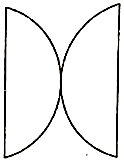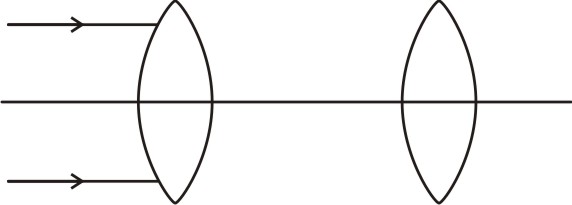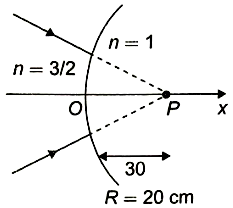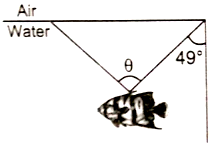A biconvex lens has a focal length of 10 cm. It is cut in half and two pieces are placed as shown. The focal length(in cm) of the final combination is:

1. 10
2. 20
3. 40
4. Not a lens


To unlock all the explanations of 6 chapters you need to be enrolled in MasterClass Course.

To unlock all the explanations of 6 chapters you need to be enrolled in MasterClass Course.
A parallel beam of light is incident on a system of two convex lenses of focal lengths = 20 cm and = 10 cm. What should be the distance between the two lenses so that rays after refraction from both the lenses pass undeviated?

1. 60 cm
2. 30 cm
3. 90 cm
4. 40 cm

To unlock all the explanations of 6 chapters you need to be enrolled in MasterClass Course.

To unlock all the explanations of 6 chapters you need to be enrolled in MasterClass Course.
A pin is placed 10 cm in front of the convex lens of focal length 20 cm and refractive index 1.5. The surface of the lens farther away from the pin is silvered and has a radius of curvature of 22 cm. How far from the lens is the final image formed?
1. 11 cm
2. 12 cm
3. 13 cm
4. 14 cm

To unlock all the explanations of 6 chapters you need to be enrolled in MasterClass Course.

To unlock all the explanations of 6 chapters you need to be enrolled in MasterClass Course.
The image for the converging beam after refraction through the curved surface is formed at:

1. x = 40 cm
2.
3.
4.

To unlock all the explanations of 6 chapters you need to be enrolled in MasterClass Course.

To unlock all the explanations of 6 chapters you need to be enrolled in MasterClass Course.
The dispersion of light in a medium implies that:
1. Lights of different wavelength travel with different speed in the medium
2. Lights of different frequencies travel with different speeds in the medium
3. The refractive index of the medium is different for different wavelength
4. All of the above

To unlock all the explanations of 6 chapters you need to be enrolled in MasterClass Course.

To unlock all the explanations of 6 chapters you need to be enrolled in MasterClass Course.
Which of the following diagrams shows correctly the dispersion of white light by a prism?


To unlock all the explanations of 6 chapters you need to be enrolled in MasterClass Course.

To unlock all the explanations of 6 chapters you need to be enrolled in MasterClass Course.
Statement I: A piece of paper placed at the position of a real image of a virtual object of intense light burns after sufficient time.
Statement II: A virtual object is that point where the incident rays appear to converge and a real image is that point at which reflected/ refracted rays actually converge.
1. Statement 1 is true, statement 2 is true; statement 2 is the correct explanation for statement 1
2. Statement 1 is true, statement 2 is true; statement 2 is NOT correct explanation for the statement 1
3. Statement 1 is true, statement 2 is false.
4. Statement 1 is false, statement 2 is true.

To unlock all the explanations of 6 chapters you need to be enrolled in MasterClass Course.

To unlock all the explanations of 6 chapters you need to be enrolled in MasterClass Course.
A person’s eye is at a height of 1.5 m. He stands in front of a 0.3 m long plane mirror whose lower edge is 0.8 m above the ground. The length of the image he sees of himself is:
1. 1.5 m
2. 1.0 m
3. 0.8 m
4. 0.6 m

To unlock all the explanations of 6 chapters you need to be enrolled in MasterClass Course.

To unlock all the explanations of 6 chapters you need to be enrolled in MasterClass Course.
A dentist has a small mirror of focal length 16 mm. He views the cavity in the tooth of a patient by holding the mirror at a distance of 8 mm from the cavity. The magnification is:
1. 1
2. 1.5
3. 2
4. 3

To unlock all the explanations of 6 chapters you need to be enrolled in MasterClass Course.

To unlock all the explanations of 6 chapters you need to be enrolled in MasterClass Course.
A fish is a little away below the surface of a lake. If the critical angle is 49°, then the fish could see things above Water surface within an angular range of ° where:

1.
2.
3.
4.

To unlock all the explanations of 6 chapters you need to be enrolled in MasterClass Course.

To unlock all the explanations of 6 chapters you need to be enrolled in MasterClass Course.






